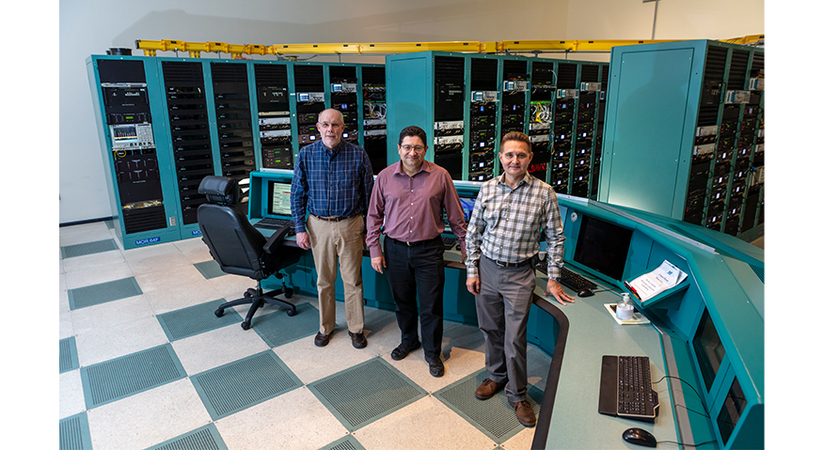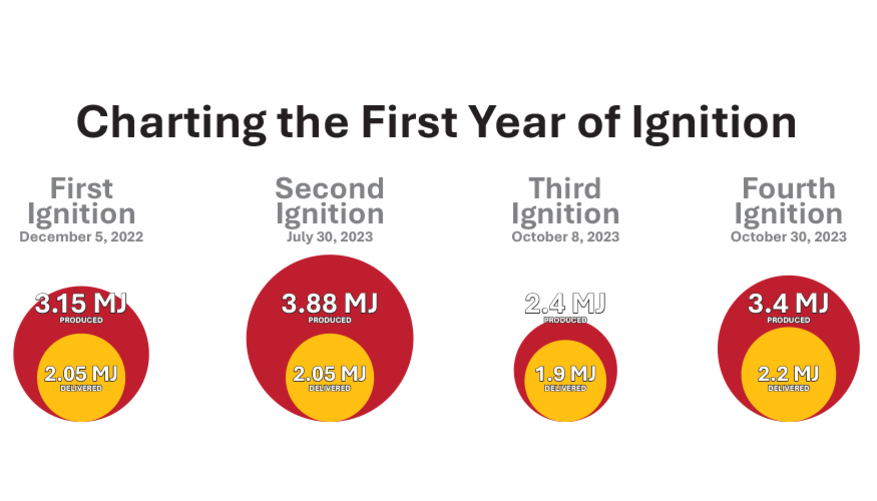
When the NIF laser delivered 2.2 MJ of laser energy, it started here in the Master Oscillator Room (MOR). Larry Pelz, Jean-Michel Di Nicola and John Heebner played key roles in this accomplishment along with the other MOR and High-Fidelity Pulse Shaping team members. Photo by Jason Laurea/LLNL.
On Oct. 30, Lawrence Livermore National Laboratory (LLNL)'s National Ignition Facility (NIF) set a new record for laser energy, firing 2.2 megajoules (MJ) of energy for the first time on an ignition target. This experiment resulted in 3.4 MJ of fusion energy yield, achieving ignition and delivering the second-highest neutron yield ever achieved on NIF.
"This record laser energy level is an incredible achievement, many years in the making," said NIF Director Gordon Brunton. "This also marks the fourth time that we have successfully demonstrated fusion ignition on the NIF. This work is foundational for the Lab's mission, with ignition enabling unprecedented capability to support the National Nuclear Security Administration's Stockpile Stewardship Program and potentially bringing us closer to a fusion energy future."
LLNL achieved fusion ignition for the first time on Dec. 5, 2022. The second time came on July 30, 2023, when in a controlled fusion experiment, the NIF laser delivered 2.05 MJ of energy to the target, resulting in 3.88 MJ of fusion energy output, the highest yield achieved to date. On Oct. 8, 2023, the NIF laser achieved fusion ignition for the third time with 1.9 MJ of laser energy resulting in 2.4 MJ of fusion energy yield.

LLNL has achieved fusion ignition on NIF four times to date.
"We're on a steep performance curve," said Jean-Michel Di Nicola, co-program director for the NIF and Photon Science Laser Science and Systems Engineering organization. "Increasing laser energy can give us more margin against issues like imperfections in the fuel capsule or asymmetry in the fuel hot spot. Higher laser energy can help achieve a more stable implosion, resulting in higher yields."
That the laser could deliver this much energy was never in doubt. The challenge lay in protecting NIF's precious optics from debris.
"The laser itself is capable of higher energy without fundamental changes to the laser," said NIF operations manager Bruno Van Wonterghem. "It's all about the control of the damage. Too much energy without proper protection, and your optics blow to pieces."
NIF is the only laser system in the world that operates above the damage threshold, a feat made possible in part by the Optics Recycle Loop.
LLNL's Optics Materials Science & Technology (OMST) program is constantly identifying new damage mechanisms and seeking ways to mitigate that damage. Those efforts stepped up in August 2021 after NIF achieved a 1.35 megajoule yield with 1.9 megajoules of laser energy.
"We were so close to ignition," Di Nicola said. "We kept working at it. We cranked up the laser to 2.05 megajoules to deliver more energy to the target and increased precision of the laser delivery. We improved target quality and fine-tuned the experimental design to maximize the impact of these changes. On Dec. 5, 2022, we did it. We achieved fusion ignition for the first time."
Hardening the optics
Two significant mitigations completed in June 2023 were critical to delivering 2.2 MJ of laser energy to the target — utilizing fused-silica debris shields on two-thirds of NIF's beamlines and installing metal shielding on 32 lower hemisphere beamlines, which reduced the debris-induced damage rate by a factor of 10 to 100, depending on the beamline. Optics in these lower beamlines receive the most debris from the Target Chamber thanks to gravity.
Other improvements included a new anti-reflective coating, vapor hexamethyldisilazane (HMDS) treatment and increased capacity in the Optics Recycle Loop. A new mitigation, the grey-edge blocker, solves a problem the scientists haven't quite identified yet.
"There is a subset of beams that don't behave as well as the others," Di Nicola said. "We found that if we cast a shadow on one edge of the beamline, essentially reducing the laser energy density, those beamlines perform better. We still don't quite understand the root of the problem but will actively investigate this issue in the future."
For the scientists and engineers who work on NIF — the world's highest-energy laser system — solving mysteries comes with the territory.
"We do careful laser damage studies and model and test the identified mitigations," said Tayyab Suratwala, OMST principal deputy. "However, every time we turn up the laser energy, we've entered unprecedented territory, revealing new damage mechanisms."
More than a hammer
More energy alone is not enough to continue NIF's incredible record of scientific breakthroughs.
"You need to wield that bigger hammer with control and finesse," Di Nicola said. "The laser pulse lasts for mere billionths of a second, so you need exquisite precision to get it just right."
To this end, the team recently finished deployment of the High-Fidelity Pulse Shaping (HiFiPS) system, which enables more precise and accurate pulse shaping. A project many years in the making, HiFiPS enables better power balance and symmetry control in implosions.
In another improvement, the team refurbished the facility's optical fibers to make them more resilient to repeated neutron exposure. These fibers are used to precisely measure the laser pulse delivered to targets. The refurbishment increased the signal strength by 10 to 100 times, allowing researchers to continue to "see" laser performance.
Looking forward
Now that the laser has delivered 2.2 MJ of laser energy, the team is back in the study phase following the same process they undertook after the first experiment that produced fusion ignition.
"We're studying the optics, assessing damage and developing an understanding of how often we can use this new capability," Suratwala said. "At the same time, we're celebrating this significant achievement. This is the culmination of years of hard work by a large team within LLNL and across many external partners."
News from: https://www.llnl.gov/article/50616/llnls-national-ignition-facility-delivers-record-laser-energy


